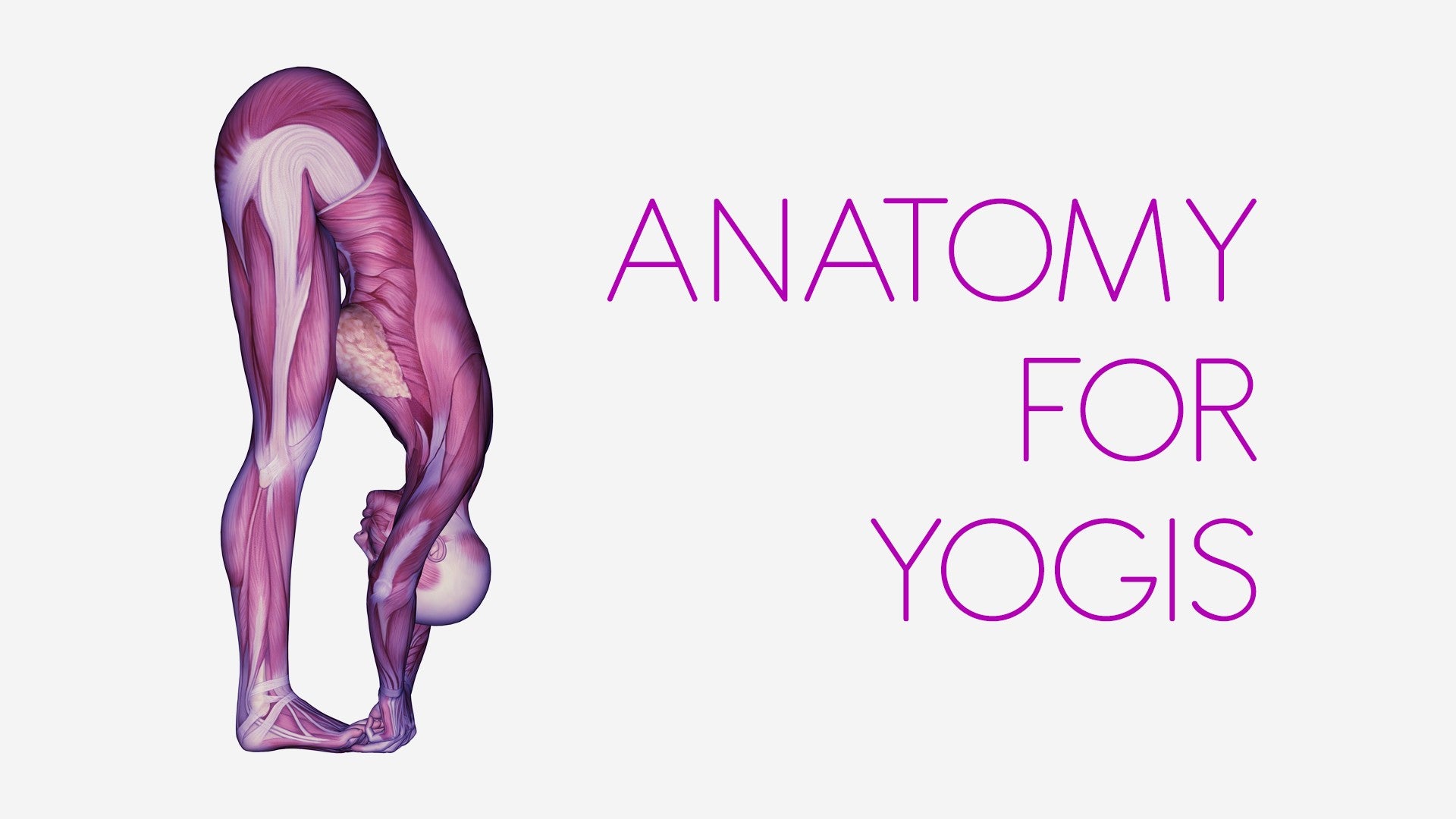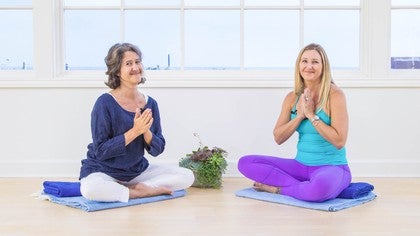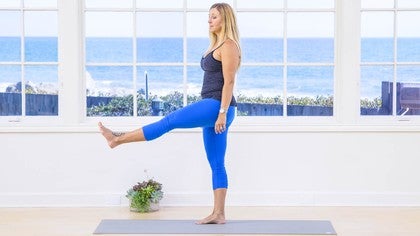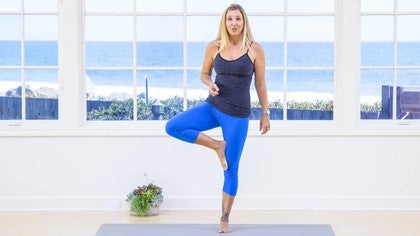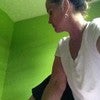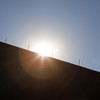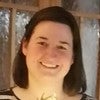Description
About This Video
Transcript
Read Full Transcript
Hi, thanks for being here. And Jules, thank you so much for being here. It's just been such an immense pleasure to witness your teaching over these last two days. So, Jules Mitchell, about a year ago, finished a groundbreaking thesis. I'll let her start to talk about it, but all I'm going to say right now is, in the best way, I hope this will transform the possibilities of your practice and your teaching. So, Jules, tell us a little bit about your thesis.
Yeah, my thesis project, I'll back up just a little. I just got a master's in exercise science, and my thesis project was kind of an accident. I knew I wanted to do something that applied to yoga, and I knew that there was something missing in the collective yoga education. There's a lot of smart people in yoga, but just collectively, I had so many questions, and I couldn't get answers. And so that's actually why I enrolled in a graduate program. And I was working with my advisor, and we were just kind of grasping at straws, like, what topic do you want to pick? And I really had no idea.
So, she just said, just start researching. Just start digging into the literature. And so I did. And I started with muscles, and I knew I wanted to do something around stretching, but I didn't know what. And I realized, wow, there's a whole language and a whole world of biomechanics and stretching and exercise and range of motion that just didn't, doesn't trickle down into the regular world. And I remember my first biomechanics class, we were talking about connective tissue, and there were, like, graphs and charts about what happens to tissues in the body when you stretch them and, like, formulas and equations. And I just sat there, like, my jaw open, like, how come we don't know about this stuff? Scientists know about this. I felt like there was this secret of how the body behaves mechanically that just never made its way into the books you buy about yoga and that kind of stuff. So, I knew that's where I was going to go after that. And then I just started collecting data.
Like, I just was, I didn't actually collect data on human subjects, but I collected the research and the literature and really started compiling all the data and realized that I really, I had, I just didn't know much. And so the project just kept unfolding and unfolding and unfolding and getting bigger and bigger as I, like, I started diving into even, like, massage research and, you know, different types of exercise research just because it all comes together. And then it even expanded so much that it turned into two parts. And one part was biomechanics and one part was the role of the nervous system because that's a whole other can of worms. And so then at one point it was like, I just have to graduate. And we finished it. That was the end of it. That was the end of it. It was my advisor was like, no more.
No one on my thesis committee wanted to read anymore. Nobody wanted to be like just done. And so I finished it. But honestly, I'm still, like, working on it. You know, I mean, even though I'm not writing the thesis, I'm constantly still in the research collecting, collecting literature and really, like, fine tuning how I understand it because things change. And there's more and more data coming out. And also it's like you can find these these articles that say one thing, but alone they don't tell you anything.
And that's why I'm so grateful that I did this because I have about 300 references, which means that when I get a new article, I don't look at what the article tells me because it just tells me how six twenty five year old men behaved after four weeks of stretching. That's all it tells me. But in the when I put it into the context of the whole body of literature, it gives me a more solid understanding of how things work. And I think that is really where this work is going to be good for the yoga community, because we like to know the answer. This is how this is how you do it. And there is no answer. We have to have a greater understanding and look at the bigger picture. So what I what I've gotten from listening to you before and now and watching you teach to is the immense courage and bravery it takes to be willing not to know.
And I just imagine that you had to go through such a process. I mean, I imagine it was just so transformative to empty, to be refilled. I had to unlearn a lot. There were a lot of ideas about movement and flexibility that I thought were the way it is. And I tell the story a lot. It's a great story. One of the most pivotal articles that really changed the way I understood things. I actually came across it quite early and I read the article and I thought it was nonsense.
It didn't fit into the paradigm of movement that I understood. And I set it aside like thinking, whatever. And it took about a year. About a year later, I had read enough of other sort of ideas and hypotheses. I remembered that article and I was like scrambling all over like piles of paper. Where is that article? Because this is the one that I needed, but I wasn't ready for it. Like early on, it was too big. My cup was too full.
And so that's one of the things I also really hope to be able to share with people is that it's okay to understand that what we have learned might not be the whole story. It seems like so much of your work, and so correct me if I'm not seeing it correctly, but the way you've been able to translate very complicated biomechanical information and very complicated understanding of the nervous systems into a format that seems to make it okay for the body to not know. It seems that you're able to work with patterns that might have been stuck for a long time and give them the opportunity to find wholeness again. Can you speak a little bit about how you do that? I don't know how I do that. It's been a journey, I have to say. But I think the real key is that once I really was able to assimilate all the research I'd done in my mind, then I realized that we are actually just like free moving bodies.
And we're in our haste to find, like this is the one, this is how you do it. In our haste to find that we've taken away so many options. And we, I mean, look at our structure. We can move in so many different ways, and so many different ways. And by trying to control that, and by trying to assign it good or bad or not flexible enough, or trying to put all these terms on it and all these outcomes, even in our very, very posture-centric yoga, you have to do this pose in order to move on to this series or whatever. We end up limiting movement by exploring movement, I feel like. And so my approach has been to take on these kind of greater laws of physics, use gravity, use props, use the knowledge of joint structures and how they move beyond the textbook, beyond the two-dimensional textbook, and how they fit together and what their potential is, and to apply that to the yoga postures.
And so that way we're exploring movement in a like unlimited way. One of the things that I loved about your classes, and I really, I can't encourage you enough to do the whole range, and Jules was so kind. She took like three-hour workshops and condensed them down to small, short classes for us. So what you're going to get here in this season is really just a taste. And you travel, you do teacher trainings, JulesMitchellYoga.com, right? JulesMitchell.com.
Jules, even easier. JulesMitchellYoga will take you there too. And she also does an entire eight-hour lecture series as well as other trainings. So you're just getting a small bite here. But really what I so loved is that it would be so easy to decide, oh, Jules makes the posture harder in one of your series, especially the one where you had Chelsea, then you had Chelsea doing things that normally would be quite easy for her, and you were finding ways to make it harder. And then another sequence, you were taking things that we make really hard and then letting them be easy-squeezy, lemon-breezy.
And so how do you just, can you share a little bit as a teacher? Because I think we end up getting not only stuck to what we know, but it's easy to get rigid into who you are and what you're doing as a teacher. And can you share some advice for teachers that want to feel more fluid but maybe are feeling stuck? Does that make sense? I think it really comes down to the balance of the two parts of my thesis. There's biomechanics and then there's a nervous system.
We live on this earth. There's no way we can avoid adapting and responding to forces. It's Newtonian physics, right? There's no way that gravity applies to us. There's no way we can avoid that.
So we have a structure that exists and that adapts and molds based on the input that it gets. And by input, I mean the movement that we do, the intensity with which we practice. So when I was finding ways to make it difficult for Chelsea, it was because I want to increase the effort to make specific changes in the tissues, right? But then on the flip side, we're still run by the nervous system. And so we still have free will in that sense.
We still have the opportunity to take gravity and make a conscious choice on how we're going to work with gravity. Whereas my beautiful succulents, they don't have a choice on how to deal with gravity. They're inanimate, right? And we have this beautiful ability to manipulate the laws of physics because we have our nervous system. So it's like a two-sided thing, but they're actually the same.
I want to use a Thomas Hanna quote. I have to think about it for a moment. I use it in my lecture. Moving and sensing are two sides of the same coin. And that's really the truth.
The experience that the nervous system gives us and movement, they're not separate at all. They have to go together. And so it's really a balance of finding when are we relying more on one and how can we reconcile them. I think that's really the essence of what I did here in the last two days. Now, your reference to the succulent brings me back to another point that you made.
That's beautiful, by the way. Thank you for buying them for me. I love them. Look at all the colors. They are for you, you know, really.
I believe the hat. Okay, good. Yes. I believe the hat. In referencing your work on your thesis, you were speaking about how no article stands alone.
Yes. And I think this is one of the difficulty things. Because it looks like we're alone, because we appear separate, unlike a plant or a tree that appears quite rooted and connected. It can be easy to forget how dependent are we on each other. And just really, from the deepest heart of the yoga community, thank you for everything you've done and everything you've brought forth, all the sacrifices you've made to bring this information for us to play with.
Because we are connected. And we need yogis. I learned recently that the proper way to say yogini is yoginis. Yogini. Yogini.
So thank you for being such a dedicated yogini. You're welcome. Thank you for having me. It's been lovely. I want to come back.
Oh, good. Promise? Yes, promise. I'm totally you. Okay, so welcome to this series.
Please let us know how it's going. Please enjoy yourself. Explore, and as Jules has said, like, move. Love.
Anatomy for Yogis: Jules Mitchell
Comments
You need to be a subscriber to post a comment.
Please Log In or Create an Account to start your free trial.
